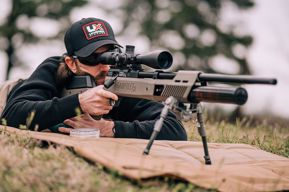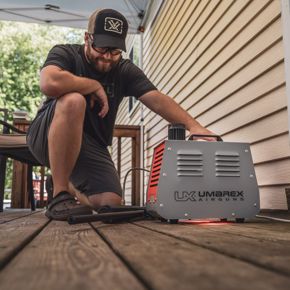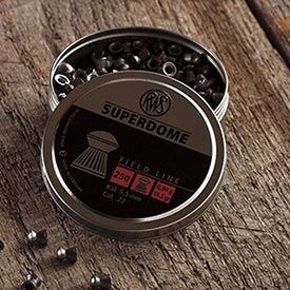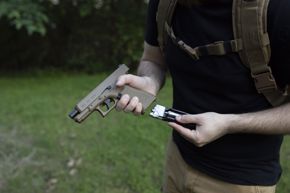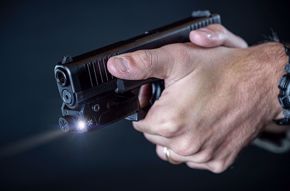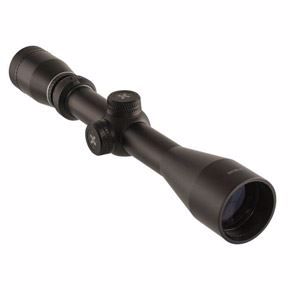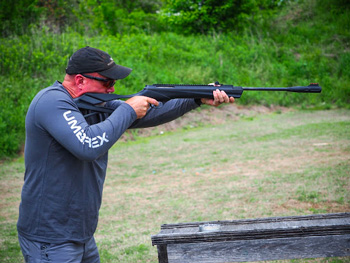 Honestly, everything that follows will be applicable to any spring or gas pistol air rifle, but the buzzword these days with self-contained power source airguns is “gas piston”, so there ya go. So what do you need to know about this style of airgun? Thankfully, little, but what little there is, it is very important.
Honestly, everything that follows will be applicable to any spring or gas pistol air rifle, but the buzzword these days with self-contained power source airguns is “gas piston”, so there ya go. So what do you need to know about this style of airgun? Thankfully, little, but what little there is, it is very important.
Without yammering on needlessly, let’s get down to brass tacks concerning living with and shooting gas piston air rifles.
First Things First: Breaking In
The first thing you need to know about a new gas pistol or spring-powered air rifle is that it will need to be broken in. Typically the break-in process takes at least 100 shots on the low end and upwards of 300 on the higher end. The new air rifle has moving parts needing to wear in and oil-coated parts from the factory. These two issues must be resolved before the rifle can be considered broken in. During the break-in, the rifle will demonstrate erratic velocity– don’t get bent out of shape about this. As a matter of fact, don’t shoot for accuracy either. Just set up your target and aim for the center. You will likely find that the shots are stringing up and down the target and left to right as well.
Gas Piston Theory
With gas piston and spring-powered air rifles you are the power source… after a manner of speaking. The energy you expend to set the gas ram or spring against the sear is stored until you release the trigger. The “cocking effort” needed to do this is described in pounds of force needed to lock the “spring” down on the sear. With standard velocity air rifles, rifles that shoot no more than 1250 FPS with lightweight pellets, the force needed to cock the rifle is around 30-35 lbs. An example of this kind of rifle would be the Umarex Surgemax Elite. A magnum-type rifle, ones that shoot above 1250 FPS with lightweight pellets, this number is in the 38-48 lbs range. An example of a magnum air rifle is the Umarex Octane Elite.
All gas piston and spring-powered air rifles essentially require the same things in order to use effectively: a strong arm, ammo, and proper technique. I’ll not dwell anymore on cocking effort– the numbers above tell the story on that and I’ll deal with ammo in another section. That leaves a paragraph or two for technique.
Because there’s some heavy stuff flinging about inside of the receiver tube and we know that every action has an equal and opposite reaction, shooting a spring-powered air rifle is really different from shooting a firearm or PCP-style air rifle. With a firearm, the recoil is in one direction and fairly sharp in force. With a PCP air rifle, recoil is essentially non-existent until you get into the bigger bore rifles. Springers have a softer push against the shoulder and a harsh forward impulse when the piston and spring come to an abrupt stop at the opposite end of the receiver tube.
It is this funky two-way recoil that destroys scopes and leads to accuracy issues. If the shooter isolates these impulses, the vibration and recoil has nowhere else to go but the end of the barrel. However, if the shooter can let the rifle float in the hands and against their cheek and shoulder, the barrel magically doesn't respond like a whip and send the pellet off in a random location on the target.
Shooters who have been around airguns for a long time call the “Artillery Hold”. Instead of gripping the forend, pushing the stock into your shoulder, and welding the cheek (bone) to the stock, the shooter lets the rifle rest in the hand, the buttstock kiss the shoulder and the cheek rest gently on the stock comb. Done consistently, this technique will eliminate 90% of accuracy issues. The remaining issues are the shooter himself and ammo selection.
Finding the Perfect Pellet
The title of this section is appropriate. The key takeaway is that air rifles, even identical air rifles, will often shoot one particular pellet very well, and the other rifle will not shoot the same pellet well at all. An unfortunate fact of life for shooting spring-powered air rifles is you may need to try several brands or styles of pellets to find the right one for your rifle.
As a general rule of thumb, the best power, measured in either foot-pounds or Joules, is found in the sweet middle of the weight range and even pellet design. Flat-tipped pellets can be a little on the lighter side of the spectrum. The flat design punches a really nice round hole through paper targets. For modest distances, this type of pellet works wonderfully well. However, the lighter weight and poor ballistic coefficient means that accuracy and power with this type of pellet falls off as distance increases.
There are some pellets that are advertised as ultra-lightweight. Regardless of shape, these pellets do fly fast. Unfortunately, that’s about all they do well. These super lightweight pellets have a tendency to deliver very poor accuracy.
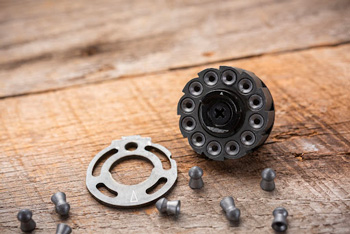 When starting your search for ammo, start with a pellet that isn’t too light or too heavy. Typically on the heavy side are a new type of pellet, at least for airguns, called the slug. These are just what they sound like, a traditional-looking pointed projectile common to firearm use. Without the malleable pellet skirt, these projectiles need a lot of air and air pressure in order to move. As such, the non-adjustable spring-powered air rifle is not suitable for shooting these. They will likely get stuck in the barrel of the rifle.
When starting your search for ammo, start with a pellet that isn’t too light or too heavy. Typically on the heavy side are a new type of pellet, at least for airguns, called the slug. These are just what they sound like, a traditional-looking pointed projectile common to firearm use. Without the malleable pellet skirt, these projectiles need a lot of air and air pressure in order to move. As such, the non-adjustable spring-powered air rifle is not suitable for shooting these. They will likely get stuck in the barrel of the rifle.
For .177 caliber, a pellet that is between 8 and 13 grains. In .22 caliber pellets that fall between 14 and 25 grains will work well. 22 caliber pellets have much more latitude in weight due to a larger air transfer port and the greater diameter of the barrel. In .25 caliber, pellets from 20 to 34 grains are the place to start.
Gas piston airguns are still very popular with shooters for their ease of use and power. Without any need for a separate pump, springers and gas pistol rifles are the cheapest way to enjoy pellet gun shooting. Yes, they are not as forgiving as a CO2 or PCP platform, but with a little practice, they can still bring you a whole lot of joy and a profound sense of satisfaction when you master the technique needed to shoot them accurately.


